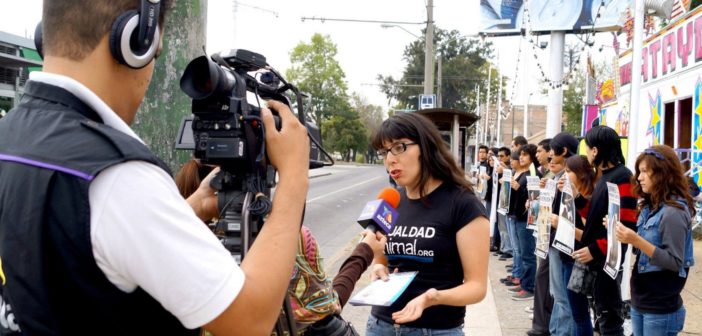Dulce Ramirez is a leader and pioneer of animal advocacy in Mexico. Under Ramirez’s leadership as Executive Director, the Mexico chapter of Igualdad Animal (Animal Equality) has made big progress for animals and raised awareness of animal cruelty, especially in circuses and industrial farms. In addition to her leadership at Igualdad Animal, Ramirez has been personally involved in undercover investigations, street activism, and various other organizations and collectives for animal advocates.
It was a pleasure to interview Dulce and talk about her path from rescuing one kitten to Executive Director of a major organization. In addition to her personal journey, we discussed the work Igualdad Animal has done, her experiences investigating animal cruelty, and the state of Mexico’s animal protection movement. We are grateful to Ramirez for taking the time to shed light on activism in a part of the world that is unfortunately so often overlooked in English-speaking animal advocacy discourse.
Our interview is presented below, with each question-and-answer pair written first in English and then in Spanish.
Dylan Forest: What inspired you to become an animal advocate? Have particular experiences fueled your fight to liberate animals, and are there other activists or thinkers you’ve been inspired by?
Dulce Ramirez: Two moments defined the before and after in my life, both on a personal level and regarding my activism. The first was when I learned about cats’ emotional lives, thanks to Miñiñi, an orange-haired kitten with green eyes. I rescued Miñiñi with the help of my mother and my sister, when she was just a few weeks old.
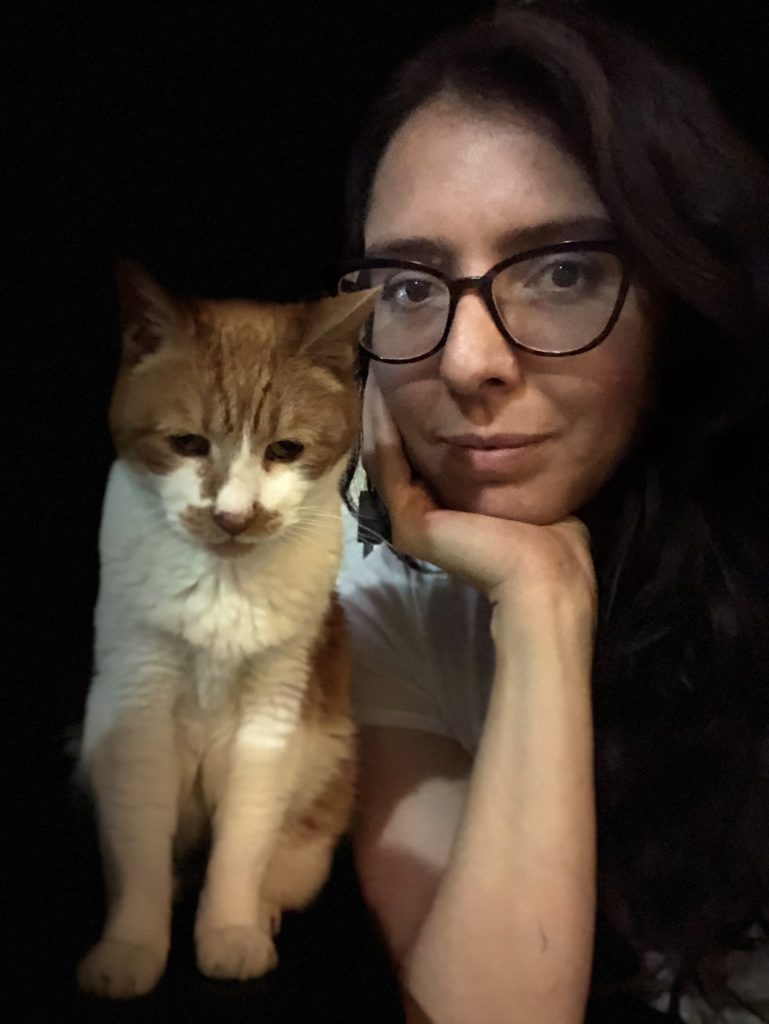
I was born in Hidalgo, Mexico, where eating sheep is very common, especially meat from baby sheep (lamb), known as “barbacoa de borrego.” I have family ties with people dedicated to raising and killing sheep, so it was the most “normal” thing to me. One Sunday morning, more than 16 years ago, my mom and I went to one of these meat stalls to eat. We started talking about Miñiñi, and then we heard about when the sheep we were going to eat was born. All of a sudden, the truth came to me, as an awakening that squeezed my chest. I told my mom: “He is a baby! It is as if we were eating Miñiñi!” We decided to stop and went back home. It was very hard. I felt terrible. Fortunately, I had my sister at the time, who inspired me to dedicate myself to activism, and she continues to inspire me today.
The second moment was when we got news from Europe about activists there who were being arrested and facing repression for defending animals. I understood how important it was to go out to show strength and solidarity in such a difficult time, and how necessary it was to continue fighting. I knew that I would dedicate my life to this. We joined actions in solidarity with the European activists, and I contacted Sharon Núñez, co-founder and president of Animal Equality. Since then, we have worked together, and she is another great inspiration. I feel great admiration for women activists, who fight together and are always there for animals. In Mexico, and maybe in the world, more than 75% of the animal rights movement is made up of women.
¿Qué te inspiró para convertirte en defensora de los animales? ¿Hay experiencias particulares que hayan alimentado tu lucha por la liberación de los animales, y hay otros activistas o pensadores en los que te hayas inspirado?
Podría decir que hubo dos cosas que definen el antes y después de mi vida personal y en el activismo. La primera fue cuando conocí la vida emocional de los gatos gracias a Miñiñi, una gatita de pelo naranja y ojos verdes que rescaté con ayuda de mi madre y mi hermana. Yo nací en un lugar de Hidalgo donde se acostumbra comer borrego, sobre todo borregos bebés, es la conocida “barbacoa de borrego”. Tengo lazos familiares con personas que se dedican a comercializar su carne, criando y matando borregos, por lo que era lo más “normal” del mundo para mí. Una mañana de un domingo, hace más de 16 años, mi mamá y yo íbamos a uno de estos puestos a comer barbacoa, y al empezar a platicar de Miñiñi y escuchar cuándo había nacido el borrego que comeriamos, me vino una verdad de golpe, así como un despertar que me apretaba el pecho, le dije a mi mamá: “¡Es un bebé, es como si nos comiéramos a la Miniñi!”. Nos levantamos y regresamos a casa, fue muy duro. Me sentía muy mal. Afortunadamente, tuve a mi hermana todo el tiempo, quien me inspiró y lo sigue haciendo para dedicarnos al activismo desde entonces.
El segundo momento fue cuando nos llegaban noticias desde Europa sobre activistas que estaban siendo detenidos y se enfrentaban a la represión por defender a los animales. En 2011 conocí increíbles activistas que al día de hoy siguen siendo colegas y amigos, entendí lo importante que era salir a mostrar fuerza y solidaridad en un momento tan difícil, y lo necesario que era seguir luchando. Supe contundentemente que dedicaría mi vida a esto. Cuando nos sumamos a las acciones en solidaridad hacia estos activistas, tuve contacto con Sharon Nuñez, fundadora y presidenta de Igualdad Animal, y desde entonces trabajamos juntas, otra gran inspiración. Siento gran admiración por las mujeres activistas, por las que luchan y se cuidan juntas y siempre están ahí para los animales. En México, y creo que en el mundo, más del 75% del movimiento de derechos animales está conformado por mujeres.
You founded the Mexico chapter of Igualdad Animal in 2012. Can you tell me about some of the successes your organization has had since then?
I remember those first years, we did a lot of street activism. We were all volunteers. We carried out many protests, against animal circuses and against bullfighting, for example. We also carried out vegan food tastings. These actions were extended to other cities besides Guadalajara—we had teams of volunteers in Mexico City, Cancún, Tijuana, and Puebla as well.
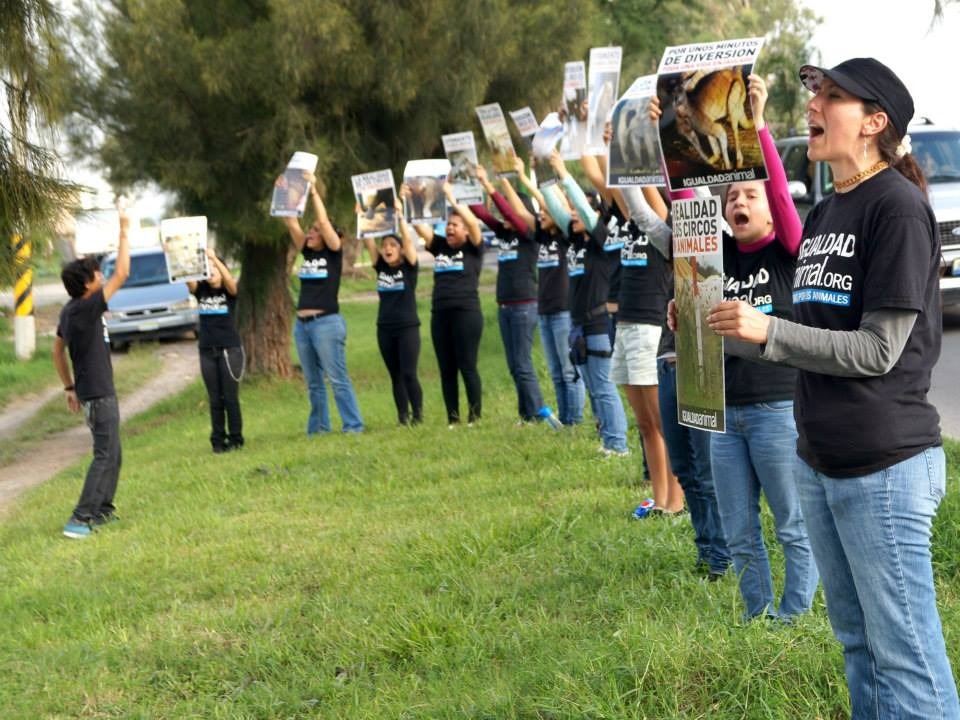
In 2012, we achieved the prohibition of animal circuses in the first municipality of Mexico, Zapopan, in the state of Jalisco. In 2013 and 2014, with local activists, we investigated 16 circuses, and the evidence we gathered there contributed to the prohibition of animals’ use in circuses in Guadalajara and in the entire state of Jalisco. Our images were used by various groups, helping them to achieve similar progress in their cities.
We’ve also helped to enact several municipal regulations and state animal protection laws. In 2019, we made Jalisco the first state in Mexico to include farmed animals under animal protection regulations in the Penal Code.
Usted fundó Igualdad Animal México en 2012. ¿Puedes contarme algunos de los éxitos que ha tenido la organización desde entonces?
Recuerdo esos primeros años de mucho activismo a pie de calle, todos éramos voluntarios y realizamos muchas protestas con diferentes temáticas: contra los circos, contra las corridas de toros. Además realizábamos degustaciones veganas. Estas acciones se extendían a otras ciudades además de Guadalajara, teníamos equipos de voluntarios en Ciudad de México, Cancún, Tijuana y Puebla.
En 2012, logramos la prohibición de circos en el primer municipio de México, Zapopan, en Jalisco. En 2013 y 2014, junto a activistas locales, investigamos 16 circos, lo que permitió que se prohibiera el uso de animales en espectáculos circenses en Guadalajara y todo el estado de Jalisco. Nuestras imágenes fueron utilizadas por diferentes grupos, ayudándoles a lograr avances también en sus ciudades.
Igualmente, realizamos diversos reglamentos municipales y leyes estatales de protección animal. En 2019 logramos que Jalisco se convirtiera en el primer estado de la República Mexicana en contemplar a los animales de granja dentro de la protección animal en el Código Penal.
What campaigns or projects is Igualdad Animal Mexico working on now?
Since 2016, the year we started to get funding and were able to open our office in Guadalajara, we have focused on helping farmed animals. We prioritized undercover investigations because there was not enough visual information about the industry in Mexico. Since then, we have launched six investigations that have allowed us to work on various education programs, legislative reforms, social responsibility policies with companies, and citizen complaints.
We have also documented the egg and the milk industry. In 2018, in collaboration with Jo-Anne McArthur of We Animals Media, we unveiled what chickens’ lives are actually like in intensive livestock farming. For the first time in our country, we documented 31 slaughterhouses. The most recent investigations we launched were about clandestine slaughterhouses and, using drones, we exposed the environmental impact of livestock farming.

¿En qué campañas o proyectos está trabajando Igualdad Animal México ahora?
Desde 2016, que fue el año en que empezamos a tener financiación y pudimos abrir nuestra oficina en Guadalajara, nos enfocarnos en ayudar a los animales de granja. Priorizamos el trabajo de investigación porque en México no se tenía mucha información visual sobre la industria. Desde entonces hemos realizado seis investigaciones que nos han permitido trabajar en distintos programas de educación, reformas legislativas, políticas de responsabilidad social con empresas, y denuncias ciudadanas.
Hemos documentado la industria del huevo, la de la leche, y en colaboración con Jo-Anne McArthur de We Animals Media, en 2018 dimos a conocer la vida de los pollos en la ganadería intensiva. También documentamos por primera vez 31 mataderos en el país. La investigación más reciente que lanzamos es sobre rastros clandestinos y el impacto ambiental de la ganadería, usando por primera vez drones para esta última.
You’ve been involved in undercover investigations on industrial farms. I imagine that these investigations can be traumatizing to the investigator. Can you talk about how you deal with that, and what gets you through your time doing the investigations?
Yes, it is very hard. For me, the best way to cope with the experience of seeing these images is to appreciate that I can focus and direct the anger they make me feel. The devastation that I feel is eclipsed by the knowledge that what we record will reach millions of people who will make decisions that benefit animals. Eduardo Galeano comes to my mind because he said, “The first condition to change reality is to know it.” And so it is: if we want to change the terrible reality that animals live, we must show it to the world. Thinking about this while holding a camera helps me.
The power of investigations is enormous, and it’s our responsibility to wield it as effectively as we can. Revealing the injustices that animals experience when a society is already fractured by poverty, inequality, and corruption is not easy. We must understand our social, political, and cultural context to achieve a positive result. Mexico is a country where social struggle is widespread, and doing research and bringing animals’ conditions to light has complex implications. Having a team that makes sure to pair each video, each photo, with the right message, is undoubtedly the best thing I can count on to move us forward. Sometimes, the memories of investigating shake us. I know they will live in me forever, but if it is during undercover investigations where I am most helpful to animals, I will have the strength to do it.
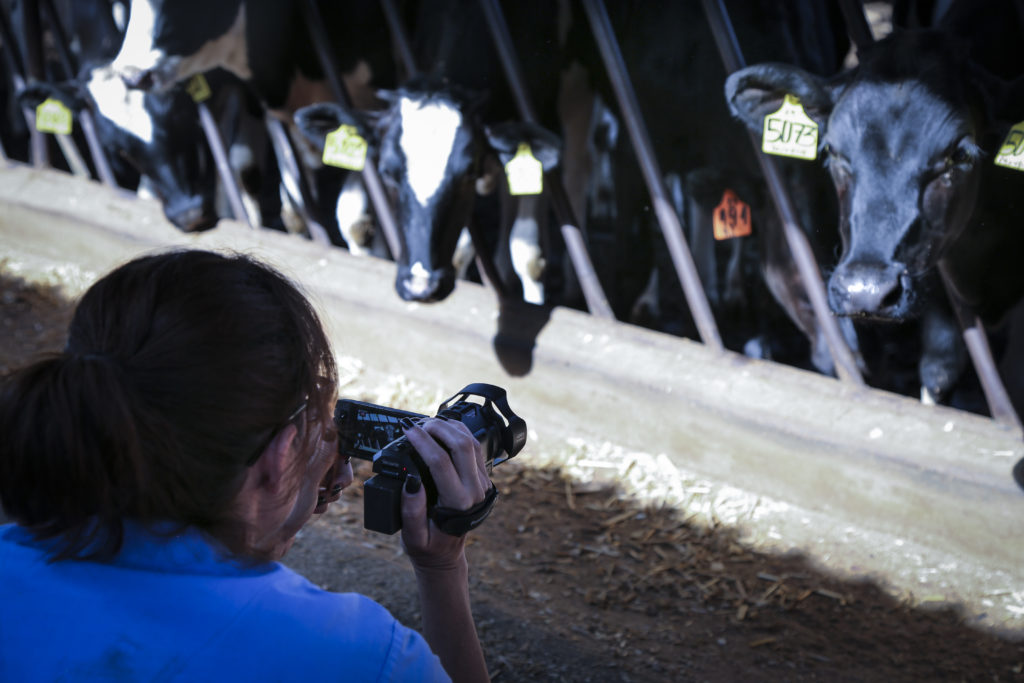
Ha participado en investigaciones encubiertas en granjas industriales. Imagino que estas investigaciones pueden ser traumatizantes para el investigador. ¿Puede hablar de cómo lidiar con eso, y qué es lo que le hace sobrellevar su tiempo haciendo las investigaciones?
Sí, es muy duro. Para mí, la mejor manera de sobrellevar la experiencia de ver estas imágenes es pensar que puedo focalizar y dirigir la rabia, la devastación que se siente se supera al saber y ver que lo que estamos grabando se potenciará y llegará a millones de personas que podrán tomar decisiones que favorezcan a los animales. Me viene a la mente Eduardo Galeano, cuando decía: “la primera condición para cambiar la realidad consiste en conocerla”, y es así: si queremos cambiar la terrible realidad que viven los animales debemos mostrarla al mundo. Pensar en esto mientras sostienes una cámara, ayuda.
El poder de las investigaciones es enorme y dependerá de nosotros usarlo lo mejor posible, revelar las injusticias que viven los animales cuando una sociedad está fracturada por la pobreza, la desigualdad y la corrupción no es fácil y debemos entender nuestro contexto social, político y cultural para lograr un resultado positivo. México es un país donde la lucha social es extendida, y hacer investigaciones y sacarlas a la luz tiene implicaciones complejas. Tener un equipo que se asegura de potenciar cada video, cada foto, con el mensaje correcto es sin duda lo mejor que puedo tener para seguir adelante. También es verdad que a ratos la memoria nos sacude con esas imágenes, sé que vivirán en mí siempre, pero si es ahí donde más le sirvo a los animales, tendré la fortaleza para hacerlo.
What has been the outcome of these investigations? Has the evidence you gathered been used to make change of some kind?
Yes, absolutely. The coverage in the national and international press achieved with the investigations has allowed us to focus on the animals most unprotected by any legislation and almost invisible in the animal protection scene: farmed animals. Our images have also been used by several groups in Mexico and Latin America. Thanks to these investigations, we have been able to present law initiatives, and we helped enact several new laws focused precisely on making farmed animals visible. Thanks to the investigations, we have been able to denounce cruelty and ensure that the law is applied.
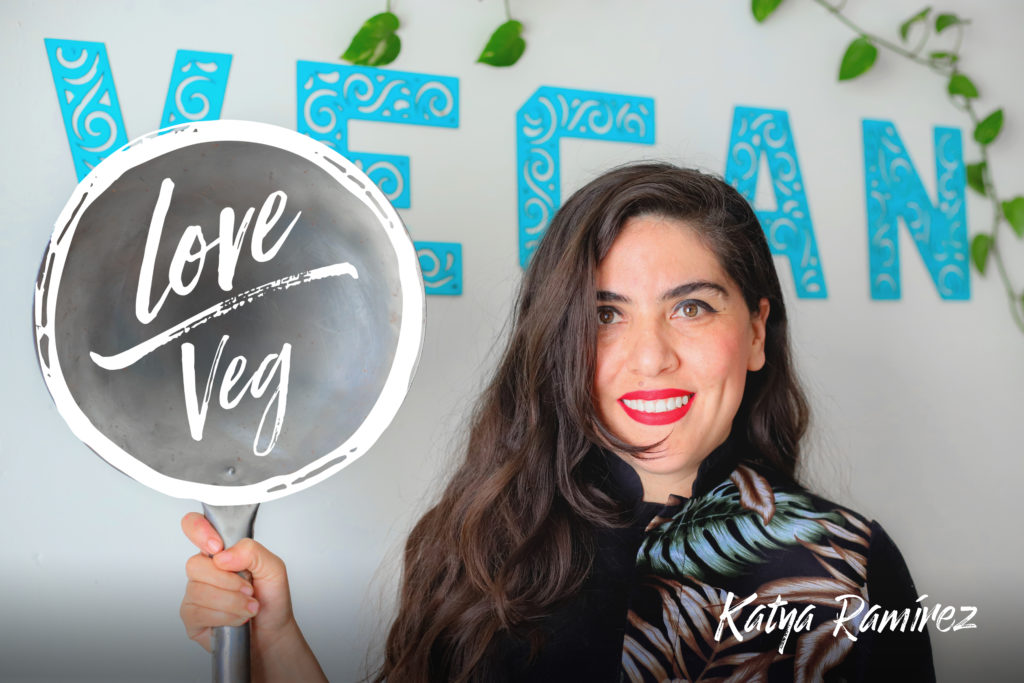
But undoubtedly, one of these last years’ great successes is to connect our investigative work with programs that answer the big “how” for people who want to make changes in their diet but do not know how to start. In these cases, the investigation becomes a bridge that connects us with thousands of people. In Mexico, we have Love Veg, an education program that already has more than half a million subscribers who want to help animals by taking them off their plates. Love Veg tell them how, providing delicious vegan recipes.
¿Cuál ha sido el resultado de estas investigaciones? ¿Las pruebas obtenidas han servido para realizar algún tipo de cambio?
Sí, totalmente. Por una parte, la repercusión en prensa nacional e internacional lograda con las investigaciones nos ha permitido posicionar y centrar el debate en los animales más desprotegidos de toda legislación y más invisibilizados en la escena de la protección animal: los animales en granjas. Nuestras imágenes han podido ser utilizadas por varios grupos en México y Latinoamérica y gracias a ellas hemos podido presentar iniciativas de ley y lograr la aprobación de varias de ellas, en donde nos hemos centrado, justamente, en visibilizar a los animales de granja.
También gracias a las investigaciones hemos podido hacer denuncias y asegurar que la ley se aplique. Pero, sin duda, de los grandes aciertos de estos últimos años es conectar el trabajo de investigación con programas que sean el gran “cómo” para las personas que quieren hacer cambios en su alimentación pero no saben bien a bien cómo empezar, en estos casos las investigaciones se vuelven un puente que nos conecta con miles de personas. En México, tenemos Love Veg, un programa de educación que ya tiene más de medio millón de personas suscritas que quieren ayudar a los animales sacándolos de sus platos.
What do you see as the most important changes that need to happen for animals in Mexico?
In the animal rights movement, I dare say that we need to overcome the ideological barriers that lead us to think that helping the animals exploited in factory farming is “all or nothing.” We have to recognize that there is an infinite range of possibilities that we can offer animals. Diverse strategies allow us to move towards what we want and fight for: animal liberation.
I am sure that the circle of compassion will continue to widen to include all animals. We will see more and more activism aimed at helping animals suffering in farms and slaughterhouses.
We also must advance law enforcement and demand public policies that provide protection and animal welfare from a legal perspective.

¿Cuáles crees que son los cambios más importantes que deben ocurrir para los animales en México?
En la escena del movimiento, me atrevo a decir que romper las barreras ideológicas que nos llevan a pensar que para los animales explotados en la ganadería industrial es el todo o nada, reconocer que existe una gama infinita de posibilidades que podemos brindarle a los animales, diversas estrategias que nos permitan avanzar a lo que queremos y por lo que luchamos, la liberación animal. Estoy segura que se seguirá ampliando el círculo de compasión en el animalismo y veremos cada vez más activismo dirigido a ayudar a los animales que sufren en granjas y mataderos. Desde la protección legal, se debe avanzar en el cumplimiento de las leyes, exigir políticas públicas que contemplen la protección y el bienestar animal.
I’d love to know more about the state of the anti-speciesism/animal rights movement in Mexico. Are there many activists and organizations working for animals, and is progress being made? Are there barriers to that progress that are specific to Mexico?
Yes, it is present. As I commented before, in Mexico we have a wide history of social struggles. The animal rights movement connects with the same values of any other battle for social justice. Veganism and anti-speciesism are a necessary political struggle, but they can also create ideological barriers that we do not want or need in our wider movement for social justice. I believe that balance is possible.
That is, I recognize the importance of ideology in order to understand the foundation of a social movement, but, before labeling others or myself, I must always ask if that is useful for the animals. Asking this question from introspection will allow us to communicate better and avoid hostility. You do not need the same tone and way of communicating at a street event where you give away vegan food and show how easy and delicious it is to stop eating animals, as you do in a debate on television with bullfighters, or in a lecture at a university. For me, that is the balance.
In Mexico, we have committed activists. Most of them have up to two jobs to finance their life and activism in their city. From various fronts, they are there, giving everything they have to help animals. I feel very proud of Mexico’s movement. We continue learning and sharing in order to be better versions of ourselves. We do this to significantly impact animals today and to help new generations continue the fight, and continue it in a better way.
Me gustaría saber más sobre el estado del movimiento antiespecista/derechos de los animales en México. ¿Hay muchos activistas y organizaciones trabajando por los animales, y se está progresando? ¿Existen barreras para ese progreso que sean específicas de México?
Está presente, sí. Como comenté antes, en México tenemos historias de luchas sociales en las que ahora el movimiento de derechos animales se reivindica como un movimiento de justicia social que tiene y conecta con los mismos valores de cualquier otra lucha. El veganismo y el antiespecismo se posicionan como una lucha política necesaria, pero también pueden crear barreras ideológicas que no queremos ni necesita el movimiento. Creo que es posible un equilibrio, es decir, reconozco la importancia de la carga ideológica para entender las bases de un movimiento social, pero antes de catalogar o etiquetar a otros o a mí misma, siempre debo preguntar ¿esto de qué le servirá a los animales? Hacer esta pregunta desde la introspección nos permitirá comunicarnos mejor y evitar la hostilidad, no es lo mismo una comunicación en un evento a pie de calle donde regalas comida vegana y quieres mostrar lo fácil y delicioso que es dejar de comer animales, que tal vez un debate en televisión con taurinos o una conferencia en una universidad. Para mí ahí está el equilibrio.

En México tenemos activistas comprometidos. La mayoría tiene hasta dos trabajos para poder financiar su vida y el activismo en su ciudad, desde distintos frentes están ahí, dando todo lo que tienen para ayudar a los animales. Me siento muy orgullosa del movimiento en México, de que seguimos aprendiendo y compartiendo juntos para ser mejores versiones de nosotros mismos que impacten significativamente a los animales y ayuden a las nuevas generaciones a seguir la lucha y seguirla mejor.
How is animal advocacy received by the general public in Mexico? Are people familiar with arguments for animal protection, and are they generally receptive to this cause?
It is complicated to give a general answer. In Mexico we have more than 126 million inhabitants, more than 62 million live in poverty, and 70% have access to the Internet. Mexico ranks first in the consumption of chicken and eggs in the world.
I do believe that progress is being made. More and more media address the problem. The supply and demand of plant-based products have grown, and now in almost all supermarkets you find vegan cheeses and meats. It is relatively easier to propose law initiatives in favor of animals, and every weekend we see activism, street actions, and digital campaigns.
So, yes, in Mexico, more and more people are informed about animals’ situations and seek to get involved, but there is still a long way to go.
¿Cómo es recibida la defensa de los animales por los ciudadanos en general en México? ¿Está la gente familiarizada con los argumentos a favor de la protección de los animales, y es generalmente receptiva a esta causa?
Es complicado responder desde la generalización. En México somos más de 126 millones de habitantes, más de 62 millones viven en pobreza y el 70% tiene acceso a internet. México ocupa los primeros lugares en consumo de carne de pollo y huevo en el mundo. Dicho esto, desde la particularidad creo que sí se está avanzando. Cada vez más, los medios de comunicación abordan la problemática, ha crecido la oferta y demanda de productos a base de plantas, ya en casi todos los supermercados encuentras quesos, chorizos y carnes vegetales, cada vez es relativamente más sencillo proponer iniciativas de ley a favor de los animales y cada fin de semana vemos activismo, acciones en calle y campañas digitales. Sí puedo decir que en México cada vez más personas no solo se informan sobre la situación de los animales, sino que buscan involucrarse, pero aún falta mucho por hacer.
Featured image: Dulce Ramirez is interviewed at a 2012 protest against the use of animals in circuses in Guadalajara. Image via Dulce Ramirez.

